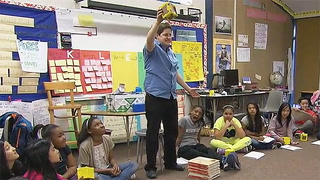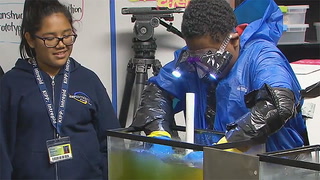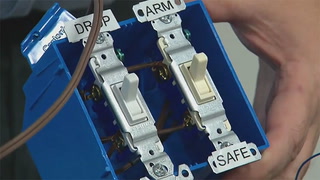Transcript for Spy Gliders:
Card:
TCH
TeachingChannel
+++ 00:00:03 +++
Student: No pressure.
Student: I’m thinking we should make like an X right here, ‘cause Xs are strong.
Student: Okay, let’s do it again.
Lower Third:
Engineering Design in the Classroom: Worrying About Weight: Spy Glider Optimization
+++ 00:00:22 +++
Julia Ward: Go ahead and turn the page so that you’re looking at adding halo. Our design test today is to adapt a glider to travel a certain distance while carrying a certain number of washers. It all started with an email, which many things start that way, about this opportunity to participate in the Boeing project.
Lower Third:
Julia Ward
8th Grade Science Teacher
Jane Adams Middle School, Seattle, WA
+++ 00:00:46 +++
Julia Ward: We all went down to Boeing and, which was really exciting. It was almost like my birthday or something ‘cause we showed up and then we were given these two engineers, like here.
Lower Third:
Paul Smith
Propulsion Analyst
The Boeing Company, Seattle, WA
Paul Smith: We all thought about the goal, the objective that we wanted the students to achieve and that was to get the feel of an engineering task, and so, we outlined the task, the objective which would be to design a glider.
+++ 00:01:15 +++
Julia Ward: My first question is how does this design task relate to our overall engineering design challenge? Chris.
Chris: Well the washers would be like the camera that the glider would be carrying.
+++ 00:01:29 +++
Julia Ward: The overall task of all the lessons is for the students to create a glider out of materials that we provide them that’s going to be released from a weather balloon, and the glider has to have a even smaller camera than a Go Pro that’s going to be attached to the glider. And the glider that goes the furthest distance and takes the steadiest shot, is the winner. When I looked at this design task, it’s not very clear. How could I make it more specific?
+++ 00:02:05 +++
Student: You could put numbers in.
Julia Ward: So I could put actual numbers in. Where might those numbers come from? Aaron.
Aaron: To show distance.
Julia Ward: So I intentionally made the design task a little bit vague, because I wanted them to do the work of connecting today’s design task with our overall task. How do I handle that second certain?
Student: You choose a certain number of washers or wait for the washers to make, or we could just find out how much the camera weighs and make it equivalent.
+++ 00:02:39 +++
Julia Ward: So make it equivalent to the camera weight?
Student: If our camera and all the gear weighs 140 grams we could put 140 grams of washers.
+++ 00:02:47 +++
Paul Smith: Her excitement behind finding a project that would make the kids exciting was really cool. We hit on the idea of kind of trying to merge technology with aviation with the design project and the spy glider, her eyes just lit up and you could tell she was really excited and really engaged, and you could tell that that’s how, she felt that’s how her students would respond.
+++ 00:03:09 +++
Julia Ward: The first thing you’re going to want to do in your table groups is come up with a process, how are you going to test your different designs? Okay so I should see everybody get together in their table groups and start immediately, go.
Student: But I’m saying you said then what happens?
Student: Yeah, so like we, we just draw like…
Student: Well that doesn’t really.
Student: …the plane flying.
Student: That wouldn’t help, no we do a diagram of where we put the washer so.
Student: Yeah.
Student: So maybe like a diagram of the plan that’s like being.
Student: So like wash airplane with washers in different positions.
Student: What?
Student: Yeah and see what flies better.
Student: Okay.
Student: This weight spread out three times.
+++ 00:03:43 +++
Julia Ward: Have you come up with steps of how you’re going to test them? What do you think would be important for like the first step when you go to do your testing?
Student: Attach the weights to the plane first and choose one person to throw them every time so it’s like similar.
Student: We’re probably going to test out Chris’ idea and see if that works, and if not then we’ll try one.
Student: Student: Student: Just distribute the weight.
Julia Ward: Okay so why?
Student: Because that was the first idea that we brought up.
Julia Ward: Okay.
Student: Well it’s also the simplest, it’s all in one…
Student: Yeah.
Student: …spot and we can find out what the design flaws are with that and then we distribute.
+++ 00:04:16 +++
Julia Ward: Okay. And that’s exactly what I’m talking about, so those are what you need to capture here is those systematic processes, so you’re being very deliberate about why you’re doing what you’re doing. They want to hurry up and test their plans and they want to hurry up and get their hands on the materials, but I hold it out almost like a carrot and I say okay, so, once you have a really well designed plan, then I’ll let you have at it, but you better have it designed first and it better be something that another
+++ 00:04:45 +++
engineer could look at and understand. You have push pins, washers, the card stock and tape at your tables, and you also have the scale so you can weigh. And you have turbo gliders. All right, great, go ahead, start.
Student: What about the plane, are we weighing it with the plane? Hey move the scale out so it’s.
Student: Wait, how much would the tape be too?
Student: Point seven.
+++ 00:05:18 +++
Paul Smith: Trying to balance, you know, the fundamental forces of flight and the dry science nature of it with getting the kids engaged and excited about it, it all comes down to hands-on, to experimentation, to picking something up, applying something that was lectured on for a few minutes, and then experimenting with it.
Student: Let’s go.
Student: It’s going to fly.
Student: I’ll throw it, I’ll throw it.
Student: Wait, one person has to throw it.
Student: Outside.
Student: Okay. Geez.
Student: You totally killed it.
+++ 00:05:54 +++
Student: Okay we got an extra foot.
Student: Hey nothing fell off.
Student: Yeah.
Student: That’s good. 28 feet.
Student: Watch out. Yes.
Student: Who threw that? Charlie why can’t you throw like that?
Student: Yes you do.
Student: 51 feet.
+++ 00:06:18 +++
Julia Ward: Their planes exploded and they all went wow it exploded, and then they went and fixed it and tried again, and tried again. I think that’s really an important part of it, and I made sure to remind them that the failure points, that not just the quantitative data but the qualitative data that they’re gathering is, it’s just as important. Okay guys it’s time to work on our posters. The next thing they had to do is make a poster and prepare a mini presentation. This is something they’re pretty used
+++ 00:06:49 +++
to in my class, a big part of what makes the work that we do authentic is that idea of sharing and communicating your information. How would you show the rest of the class that you used a systematic process to get those results?
Student: We can show one of our papers.
Student: Show this page right?
+++ 00:07:12 +++
Paul Smith: We need to teach both science and the application of science. To be able to go through the design process, go through the experimentation process, go through the build process, by applying the skills that they learned in the science classroom, is fundamental I think.
Student: On our first trial we got 28 feet and on our second trial we got 24 feet.
+++ 00:07:33 +++
Julia Ward: I was really pleased with how well the students did. It was just that right level of challenging and frustrating for the kids, and that it really, really got them talking in a really authentic way. They really wanted to solve the problem, they really were excited about the task at hand.
















4 Comments
Lesli Adamo Nov 11, 2020 2:30pm
I like that the teacher kept it vague so the kids become in charge of their learning.
wei xiaohong Apr 8, 2018 2:13am
wei xiaohong Apr 8, 2018 1:11am
Tonya Dorsey Oct 7, 2015 10:26am